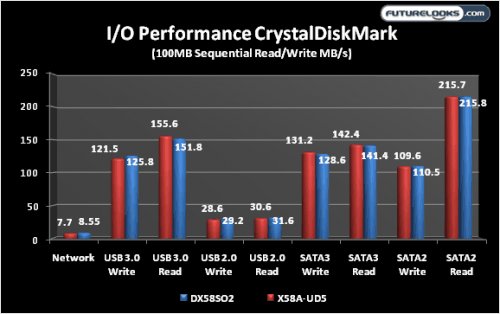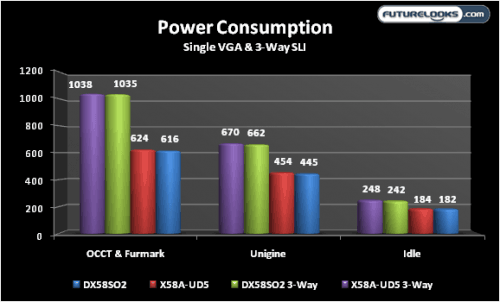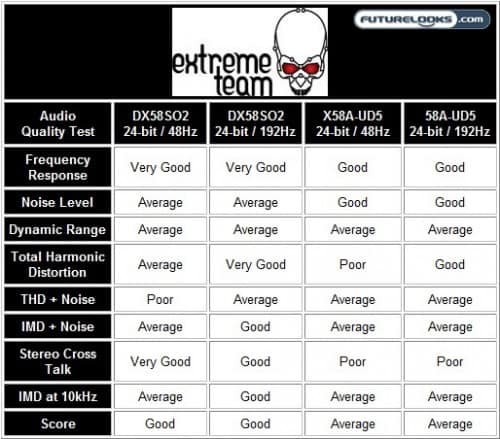Input/Output Performance
We’re looking for any benefits between the platforms in terms of expansion, data rates, and network. Many of the storage controllers are the same these days, so it comes down to integration and BIOS tuning.
The results are interesting in that the UD5 does better with USB 3.0 thanks to their “333” implementation while the SO2 does better with SATA. Also, the Intel LAN Pro network controller is a bit more efficient. You probably won’t notice the difference by itself at home or office, but you would get a little more out of it over a local area network if the two systems were downloading at the same time.
Power Consumption and Quality Control
Any X58 system running high end graphics like the GTX 580 will consume some power at load. The DX58SO2 build needed only 182 watts at idle and 445 watts at load with a single GTX 580. But, it’s amazing how 3-way SLI tosses just about any and all consumption right out the window. That’s just how it is when running crazy gaming systems. Still, it is a slightly lower consumer of power than the UD5.
In terms of quality, both the SO2 and UD5 are immaculate. Neither seem to have a component out of place. The S02 is entirely silent at all times during any operation. However, there are some squeaks and squawks that penalize the UD5 more especially during full load. This is evident during audio testing.
Audio Performance
When you pack a lot of components on to a motherboard, it’s not uncommon for a couple small implementation issues to happen. Audio testing often reveals these issues. In this test, RightMarkAudio Analyzer was used to measure 24-bit 48Hz and 192Hz audio performance while looking for any issues.
The SO2’s audio also suffers from some noise when it comes down to it. There is just ever slightly too much (THD + Noise) total harmonic distortion and noise at peak volumes. But, that’s all it suffers from in the 24-bit 48Hz range. The higher 192Hz test does better and audio quality is overall good.
As we’ve seen before, the UD5 suffers from THD and noticeable stereo crosstalk. In other words, you can hear the slight squelching when the motherboard’s circuits get noisier during loaded tasks. The only way to eliminate that is turn up the audio levels. The best it can provide is an average score through out.
Final Thoughts
Does the Core i7-990X and Smackover 2 Bring the Smack Down? Not really. If you were expecting a large performance difference between the 990X and 980X, you’re not alone. The fact of the matter is that they really aren’t intended to break through any real barriers. Both are nice revisions of their former siblings and bring all of the features up to date especially the motherboard. The CPU itself is another refresh of the Core i7-980X with slightly better tuning. If you’re trying to save some money, we’d recommend the Core i7-970 for a surprising $594 USD which is a slightly slower core. Still, the end result is a possible new combination upgrade if you need the best processing power available.
We do have to say that this is update for the motherboard a bit past its prime. We’re surprised it didn’t launch when the rest of the partners brought us USB 3.0 and SATA3. However, it’s nice to see their own X58 platform with more character than the last revision. In this market, identity is very important and the Skull is the identity of the Smack Over. INTEL’s new flagship board will only cost you $250 to $275 USD depending on the retailer and even less if bundled with an INTEL CPU. That’s not too bad at all really.
Still, as we close in on the Intel Z Series platform release, we’re curious to see what the motherboard group brings us next!
INTEL Core i7-990X LGA1366 CPU
Pros
- Fastest desktop 6-core processor there is!
- Slight frequency bump without require more power
- Overclocks well as usual
- Doesn’t require a BIOS update
Cons
- It still costs about $999 USD
Overall Rating: 9.0 / 10.0

Intel DX58SO2 Smackover 2 LGA1366 Motherboard
Pros
- Finally, SATA 3 and USB 3.0 support
- Better design than the previous DX58SO
- Very handy BIOS recovery feature
- Very affordable X58 3-way SLI motherboard
Intel DX58SO2 Cons
- Just a bit late to the party
- Won’t satisfy the aggressive overclocker
Overall Rating: 8.5 / 10.0

Love This Review? Hate This Review? Leave a Comment Below!




